Late this past Saturday evening Twitter users opened their social-media accounts to find that the adorable iconic blue bird had been replaced by a stark black “X,” the platform’s new name. The change had been well-publicized, and owner and chief technology officer Elon Musk previously had messaged: “Soon we shall bid adieu to the Twitter brand and, gradually, all the birds.”
Still, after 17 years of gliding in social-media space, flipping the bird to “X” landed with a hard thump for most.
“Rebranding is very useful and helpful when you want to change peoples’ minds and their perceptions,” explained Joseph Johnson, an associate marketing professor at the University of Miami Patti and Allan Herbert Business School. “When there’s a crisis or your brand is doing really badly, you have to refocus your brand in the eyes of consumers. Those are the times when you do these things,” he continued.

“It’s very hard and takes a number of years, a lot of media effort, a lot of consistent targeting and messaging to change peoples’ perceptions,” added Johnson, who is also a member of the AI and Big Data Center at the Frost Institute for Data Science and Computing (IDSC).
Johnson cited as examples the cases of Sea World, which revamped its brand in the wake of associations to animal abuse and financial precarity, and Facebook's move to Meta as it wanted to expand the meaning of the platform.
Like many customers and pundits, Johnson admitted that he’s befuddled by how Musk has managed the move.
“He says the company is doing badly, and that he wants to give it a fresh look. That makes sense because he’s new [Musk purchased Twitter in October 2022 for $44 billion],” Johnson said. “Yet it appears he hasn’t thought through the reasons for the rebranding.”
Johnson referenced the many media reports that indicate Musk is obsessed with the concept of “X”—to the point that, together with his partner, in 2020, he even named his newborn son “X Æ A-12” (pronounced X-Ash-A-12).
“There’s nothing wrong with personal motivation, but the question is if customers are going to share your motivation,” Johnson noted. “As a brand manager you have an unwritten agreement with your customers, and your personal likes and dislikes shouldn’t play much of a role.
“The word ‘Twitter’ and the bird were so beautiful, and people loved the small bird and the color scheme,” he said. “You cannot assume that what you like is what the universe likes or that you can impose your likes on the universe. That’s the problem for customers, company employees, and investors.”
Uzma Khan, also an associate professor in the Department of Marketing, recognized that Musk’s rebranding—together with other decisions he has made regarding the platform—point to a short-term free fall. But she suggested that seen from the framework of a visionary, longer-term perspective, the decision makes sense.

To understand what’s behind Musk’s thinking, Khan, a specialist on consumer behavior, strategy, and branding, said it was important to step back and understand what brands are and how they operate. She defined them as a set of associations either positive or negative—“a neural-network of memory”—that to a large degree evolve automatically.
“The stronger the associations are, and the more positive they are, the better your brand is,” she explained.
Customer preferences, tastes, and demographics, such as the decision to reach a younger audience segment, change. And it’s often necessary for companies to refresh their products or undertake a brand “extension” to include new areas that help maintain or entice new customers, she pointed out.
Yet, she contrasted this common practice with the “reset” that’s happening with Twitter.
“Reset is where the brand changes its course—the brand’s strategic vision changes—such as we’ve seen with tech giants like Google to Alphabet, Facebook to Meta, etc.,” Khan said. “They’re saying: ‘We don’t want to be just Google anymore; we want to be bigger.’ ”
With this move, Musk is essentially saying that he wants to do bigger things with Twitter, Khan indicated, while highlighting that it’s important to remember that the billionaire entrepreneur owns and controls several companies.
With this ambition in mind, Khan noted that Musk had two options: Either launch X on its own or rebrand something of what he already has.
“Twitter is a newly acquired brand that has more generalized competencies, so he can do more with Twitter than with any of his other brands. He wants to extend it to be anything and everything, a sort of WeChat [the Chinese messaging, social media, and payment app],” Khan said.
Is Musk making a bad move by destroying the Twitter brand?
“I’m not 100 percent sure this rebranding is going to be the downfall of Twitter,” said Khan, responding to the question that many seem to be asking. “Twitter has been on the downturn for some time, so maybe it’s worth taking a risk even if the brand dies.”
Analyzing the reset strategically and from a longer-term optic unfolds a different, albeit uncertain, outcome, she conveyed.
“Pundits and experts have all been saying he’s mad,’’ Khan said. “But I’ve yet to hear someone ask where would Twitter have been in 10 years if Musk didn’t X it? It had to morph into something else like any of these previous social media platforms. They’re all gone because something new comes in.”
“Maybe he’s not looking at Twitter from the perspective of where it is now, but where it would have been in five or 10 years if it stayed its course,” she added. “Maybe after doing their projections, they decided there’s no clear trajectory where it’s headed. Younger customers, they’re not coming to Twitter. They’ve got TikTok.”
The big question is that no one knows what the world’s wealthiest human being is really trying to do. Considering his options, the reset rebrand appears to make sense, she said.
“Starting a new brand is really hard. You need to build brand associations and marketing and develop relationships,” she spelled out. “Twitter has its suppliers, its buyers, and it has all that infrastructure of relationships.
The refreshing of a brand that involves changing a logo, stationery, or a website is relatively easy to accomplish.
“But to build relationships, contracts, agreements, permissions to operate in different countries from scratch is hard. Twitter possesses those already. And that gives Elon Musk leverage that starting a new brand would take years to build, Khan said.”
She returned to the X factor of what Musk has in mind for the platform.
“Elon came on board, and the brand started to shake. But even if that hadn’t happened, where was Twitter going to go? We don’t know where he’s going to take it, but this could actually be the best thing,” Khan said.

